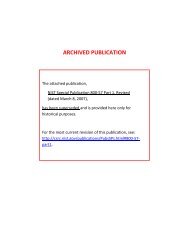NISTIR 7298 Revision 1, Glossary of Key Information Security Terms
NISTIR 7298 Revision 1, Glossary of Key Information Security Terms
NISTIR 7298 Revision 1, Glossary of Key Information Security Terms
Create successful ePaper yourself
Turn your PDF publications into a flip-book with our unique Google optimized e-Paper software.
NIST IR <strong>7298</strong> <strong>Revision</strong> 1, <strong>Glossary</strong> <strong>of</strong> <strong>Key</strong> <strong>Information</strong> <strong>Security</strong> <strong>Terms</strong><br />
Multiple Component Incident – A single incident that encompasses two or more incidents.<br />
SOURCE: SP 800-61<br />
Multiple <strong>Security</strong> Levels (MSL) – Capability <strong>of</strong> an information system that is trusted to contain, and<br />
maintain separation between, resources (particularly stored data) <strong>of</strong><br />
different security domains.<br />
SOURCE: CNSSI-4009<br />
Mutual Authentication – Occurs when parties at both ends <strong>of</strong> a communication activity<br />
authenticate each other.<br />
SOURCE: SP 800-32<br />
The process <strong>of</strong> both entities involved in a transaction verifying each<br />
other.<br />
SOURCE: CNSSI-4009<br />
Mutual Suspicion – Condition in which two information systems need to rely upon each<br />
other to perform a service, yet neither trusts the other to properly<br />
protect shared data.<br />
SOURCE: CNSSI-4009<br />
Naming Authority – An organizational entity responsible for assigning distinguished<br />
names (DNs) and for assuring that each DN is meaningful and unique<br />
within its domain.<br />
SOURCE: SP 800-32<br />
National <strong>Information</strong> Assurance<br />
Partnership (NIAP) –<br />
A U.S. government initiative established to promote the use <strong>of</strong><br />
evaluated information systems products and champion the<br />
development and use <strong>of</strong> national and international standards for<br />
information technology security. NIAP was originally established as<br />
a collaboration between the National Institute <strong>of</strong> Standards and<br />
Technology (NIST) and the National <strong>Security</strong> Agency (NSA) in<br />
fulfilling their respective responsibilities under P.L. 100-235<br />
(Computer <strong>Security</strong> Act <strong>of</strong> 1987). NIST <strong>of</strong>ficially withdrew from the<br />
partnership in 2007 but NSA continues to manage and operate the<br />
program. The key operational component <strong>of</strong> NIAP is the Common<br />
Criteria Evaluation and Validation Scheme (CCEVS) which is the<br />
only U.S. government-sponsored and endorsed program for<br />
conducting internationally recognized security evaluations <strong>of</strong><br />
commercial <strong>of</strong>f-the-shelf (COTS) <strong>Information</strong> Assurance (IA) and<br />
IA-enabled information technology products. NIAP employs the<br />
CCEVS to provide government oversight or “validation” to U.S. CC<br />
evaluations to ensure correct conformance to the International<br />
Common Criteria for IT <strong>Security</strong> Evaluation (ISO/IEC 15408).<br />
SOURCE: CNSSI-4009<br />
Pg 123

















